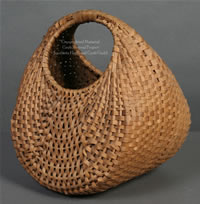Baskets
Basketmaking—or basket weaving—was a popular craft during the Craft Revival. Unlike some other craft skills thought to be “lost arts,” basketmaking was actively practiced at the start of the Revival. The usefulness of baskets contributed to their popularity. Basket forms included: market baskets, storage baskets, laundry baskets, waste baskets, fruit and flower baskets, egg baskets, trays, and purses.
In the Appalachians, both before and during the Craft Revival, baskets were made from a variety of materials. By far the most common material for non-Cherokee baskets was white oak. These baskets were made from a young oak sapling that was split laterally again and again to form long, supple splits or splints. Woven over a framework of ribs, split oak baskets were sturdy.
Basketmaking was a tradition among western North Carolina’s Cherokee peoples. The Cherokee also used white oak—it grew abundantly in Appalachian forests—as well as maple and rivercane. Rivercane was used almost exclusively by the Cherokee who devised a complex method of basketmaking called the “double weave,” which produces a double-layered basket.
In his 1937 book Handicrafts of the Southern Highlands, Allen Eaton made the following observations about basketmaking during the Craft Revival:
Among the materials from which baskets are made are broom sedge, corn husks, corn stalks, wheat and rye straw, oziers (willows), both branch and twigs, rushes, cane, honeysuckle vine, inner bark of pine, hickory bark, peeled willow bark, pine needles, and oftenest of all splints of oak, hickory, and ash. All these grow throughout the Highlands except the long-leaf pine needles, which usually come from the lower lands of North Carolina, Georgia, and Alabama. In a few instances baskets are made of raffia and reed, articles of commerce imported from other countries. White oak or basket oak, as it is commonly known in the mountains, and hickory are the materials generally used in baskets made of splints.
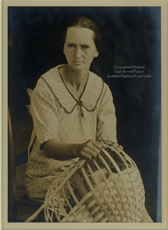
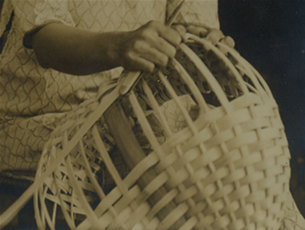
Doris Ulmann photographed this unidentified woman in the early 1930s. She is weaving white oak into a basket.
The Cherokee Indians on their reservation at Cherokee, Swain County, North Carolina, make a wide variety of baskets, using split oak, honeysuckle, but especially split [river] cane, a strong, durable native plant of the bamboo family. The [river] cane is a very difficult fiber to work as it is hard and tough and must be kept wet, but the Cherokees have employed it as far back as memory goes. The shapes made include carrying baskets, arrow quivers, and other forms of value in their own life, also many for general use. Frequently the cane is colored with native dyes.
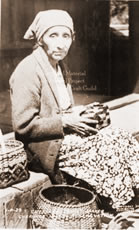
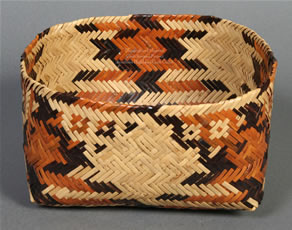
Nancy Bradley, Cherokee basket maker
with
complex double weave basket made from traditional rivercane
An ideal material for baskets is the native honeysuckle which covers old fences, banks along the roadsides, and countless other places throughout the Highlands. It is tough, pliable, smooth, and durable. Several basket makers use this native vine, but none with more skill than Lena and Flora Dysart who live on the old homeplace, near Rydal, Bartow County, Georgia. In a letter they describe their work:
We gather the vines from our own farm. They run straight and do not cling to anything. We gather a quantity fifteen and twenty feet long in winter when sap is down, wind them in rolls, fasten securely, and boil four hours. Remove from pot, run each piece through a cloth to remove bark, soak overnight in a tub of water, rinse in two waters, and hang in sunshine to dry. Then, we whittle off each little knot with a sharp pocket knife and then they are ready for weaving. We do all the work ourselves from gathering the vine to finished article.
[Willow] bark is gathered in the summer when there is a nice smooth sap on it. It is skinned from the willow tree, the hard outside part of the bark is removed before it is left to dry. When dry the rough side is smoothed with a knife—the side which is seen on the inside of the basket—and the bark is then cut in splints and woven into the basket.
Pine-needle baskets are made in the vicinity of Asheville from needles shipped in from outside the Highlands. They are also made in northern Georgia and northeastern Alabama, whence pine needles are sent for the purpose. While a few of these baskets are made entirely of the long-leaf pine needles, most are combined with raffia, which is an excellent tying material and oftentimes contributes much to the design and color scheme.
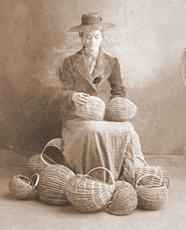
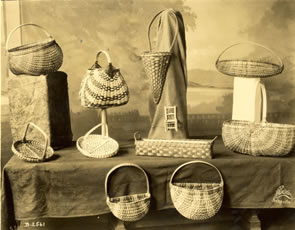
While not easy to make, baskets were lightweight and highly functional,
traits that contributed to their popularity during the Craft Revival
The usefulness of baskets made them a popular as household items. Their porosity made them perfect for storing dried foodstuffs or clothing because air circulating through the stored goods contributed to their preservation. Often, baskets were designed for a particular function. Eaton described an egg basket that both protected and measured the eggs that it carried. Its rounded-bottomed form allowed the eggs to settle to the bottom of the basket without rolling around and cracking against each other. Moreover, Eaton told of having heard of baskets “made in standard sizes to hold even dozens of eggs, making counting unnecessary, as filling the basket performed this service.” Such purposeful design contributed to the aesthetic of the Craft Revival.
- Edited by M. Anna Fariello, 2008
Transcriptions from Allen Eaton, Handicrafts of the Southern Highlands (New York: Russell Sage, 1937)
See More: Baskets, Basket makers
